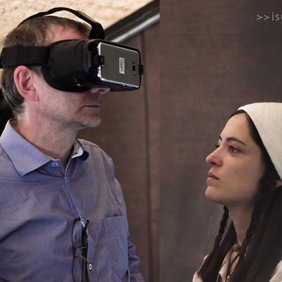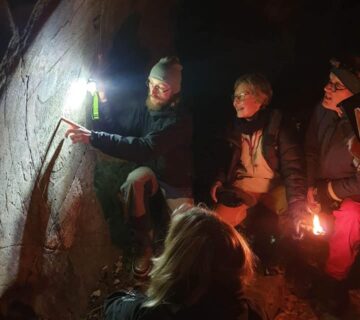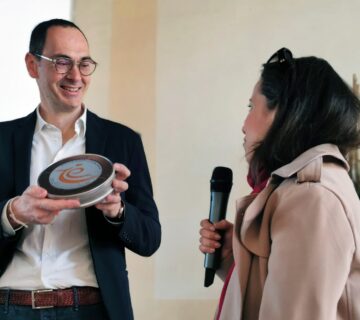In the first stage of the adventure game the visitor (i.e. the time traveller wearing VR goggles) meets a Bronze age Vatya woman (Image: Szekér)
How can an interpretation expert contribute to the development of a heritage programme other than on the content level? What if the expertise for content is already given, but other questions are not clarified? We followed an entire cooperation project and used interpretive evaluation to help achieve its aims.
Archaeologists can make a significant cultural impact by discovering lost phenomena and related meanings or creating new meanings in connection to specific sites. Inherently, their work may disrupt the already established ways of engagement people had towards heritage; this may rejuvenate existing connections, confront others and create new ones. A number of questions go hand in hand with this work: By whom and how far are certain locally occurring phenomena considered significant? Who should care for them and why? In other words: Whose heritage are we talking about?
This is when the role of interpretation comes into the picture, enabling site managers and other stakeholders to create meaningful links between the people and the given place. Its success lies in providing first-hand experiences, while also enabling individuals to live through different types and qualities of experiences. At the same time, through interpretation a communication channel opens, through which past and present realities meet and collide. This latter point we find important, as providing clues – or referential points – for individual and collective identities is central to the concept of heritage. Based on this, one should underline that interpretation is much more than experiential presentation. It has a mission – just like heritage sites do. Interpretive evaluation is partly about the investigation into how far this mission is fulfilled. On the other hand, it is instrumental for getting to know the potential ‘heirs’. In order to appropriately consider them in relation to any particular place, one has to value them, to know who they are, why they come to visit, and what experiences they would take home.
The ‘Journey to the Beginnings’ project (journeytothebeginnings.eu) was an international cooperation, running between the Autumn of 2018 and February 2020, funded by the Creative Europe programme of the European Commission. The main outcome of the project was a prehistoric theatre-adventure game, designed also for digital mobile platforms to promote sustainable, art-based heritage tourism at four sites along the Danube (Gârla-Mare, Lepenski Vir, Vučedol, Vatya), presenting prehistoric archaeological cultures and archaeological research in the context of a joint narrative.
One of the challenges in similar projects is, that the local site managements mostly expect to have the attractions presented in experiential, entertaining and attractive ways, beyond dry scientific facts, in order to help their visitors develop an affinity to certain historical periods or cultures. In our opinion, however, approaching the projects this way implies two problems. On the one hand, the potential of interpretive practices is underestimated, as they can go far beyond developing an affinity to something. On the other hand, the outcomes of such projects are very difficult – if not impossible – to measure, as it is hard to tell whether the (real or imagined) positive feedback is due to visitors being entertained or if there is, indeed, an educational experience.
Another challenge is that this kind of collaboration starts from a situation where the project participants have not – or only barely – known one-another, and basically had no previous experience in working together. Representatives of different professional fields need to find a common language and create a joint product. Thus, the task is both product development and experimental cooperation, where the process is just as important as the final product.
For us, members of KÖME, the challenge was to bring in the interpretive approach to a process where it had no pre-assigned place. To bring the approach closer to the site managers, archaeologists and the artistic team responsible for the content development. We took the opportunity to follow through the collaboration in its complexity and to apply interpretive evaluation in order to create a platform to realise the common goals of the project, to introduce a common language and to synchronise different motivations, needs, mind-sets and work methods. Interpretive evaluations by a third-party can really progress or even provoke the consultations between project members. Also, due to its holistic methodology, the evaluation process carried out throughout the project can help the participants in consciously considering their goals and opportunities right from the beginning.
If you want to know more about our one-and-a-half-year long journey, about the methods we used and some of the main learning points, you can find our full paper in the 2020 spring edition of Hungarian Archaeology e-journal at the following link: http://files.archaeolingua.hu/2020TA/Upload/Boczen_E20TA.pdf
Árpád Bőczén is a Hungarian architect and heritage expert working on various projects as the president of KÖME (Association of Cultural Heritage Managers – heritagemanager.hu). He can be contacted at: arpad@heritagemanager.hu.
Zsuzsa Berecz is a Budapest-based dramaturg and curator. She has been active in artistic and community-based projects and is the vice-president of KÖME Association of Cultural Heritage Managers.
To cite this article:
Bőczén, Árpád and Berecz, Zsuzsa (2020) ‘Journey to the Beginnings’. In Interpret Europe Newsletter 2-2020, 27-28.
Available online: https://www.interpret-europe.net/fileadmin/Documents/publications/Newsletters/Newsletter_summer_2020.pdf




